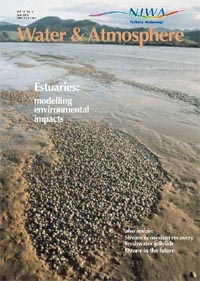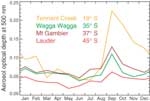PDF of this article (1 MB)

Ben Liley
The products of burning in the tropics can be detected in the atmosphere as far away as New Zealand.
When bush fires rage across parts of Australia, as they did from Boxing Day 2001, they produce spectacular sunsets, and sometimes a haze visible by day as the plume crosses the Tasman Sea. Though less visible here, the products of regular large-scale burning travel much greater distances, with implications for atmospheric chemistry and radiation across the globe.
Every year in the tropical dry season vast areas of savannah and crop land in southern Africa, South America, southern Asia and northern Australia are burned in preparation for new growth or replanting. For one or two months every spring, at NIWA’s Lauder station in Central Otago, half a world away from some of the fires, their products dominate measurements of several kinds of gas, of aerosols, and of their optical effects.
Products of burning
Most burning biomass is converted to carbon dioxide and water, with the latter forming the visible clouds of smoke. Incomplete combustion produces carbon monoxide, soot, and a wide variety of hydrocarbons. Compounds of sulphur, nitrogen, and other elements are also released, and the heat of burning produces oxides of atmospheric nitrogen. Some of these products are short-lived or are soon lost in high background concentrations. Carbon monoxide, ethane and several other hydrocarbons can be detected and measured in affected air masses, even at large distances from the source.

Murray McEachern (UC–Irvine) collecting air samples for trace gas analysis.


Along with the gases produced by burning, there is also a great variety of aerosols formed directly in combustion or by condensation in the plume. These tiny particles can remain suspended in the atmosphere for months if not removed by clouds or rain. Their persistence for such a long time is typical in the cloud-free stratosphere. The contour plot shows backscatter from aerosols, as measured with instruments carried by balloons launched monthly at Lauder from 1992 until 1999. Above the tropopause, the sulphate aerosol loading from the eruption of Mt Pinatubo in 1991 decreased only gradually through removal by settling and mixing into the troposphere. In contrast, aerosol removal from the troposphere is rapid. This means that the types and concentrations of aerosols above and below the tropopause bear little relationship to each other.
A seasonal pattern
The plot of aerosol optical depth shows a clear seasonal pattern of increased aerosol concentrations at 5–8 km altitude in spring each year. The pattern is visible against a background of consistently clear air in the Southern Hemisphere mid-troposphere, and at these altitudes we expect that aerosols have travelled from a very distant source. Because the pattern is so regular and aerosol is removed within days (or at most a few weeks), we deduce that the source must be large and could be biomass burning.
Data from a Fourier Transform Spectrometer (FTS) at Lauder support this conclusion. The instrument measures absorption of sunlight in the infrared region of the spectrum and can determine the amounts of hundreds of gases in the air column. Results from the FTS show that carbon monoxide, ethane and hydrogen cyanide – all products of burning – are most abundant over New Zealand in early springtime. For strong absorbers of infrared radiation, FTS measurements also provide an idea of their vertical distribution in the atmosphere. Carbon monoxide is one of these gases, and the FTS plot shows a close correlation between aerosol backscatter and carbon monoxide.
Tropical origins
By tracking affected air masses backwards in time using general circulation models of the atmosphere, we can trace them to tropical regions, often over Africa or even South America. To reach half a world away and halfway to the South Pole, the pollutants must be spread over much of the Earth’s surface, and at high initial concentrations.
It is possible to detect variations in concentration with latitude by measuring aerosol optical depth – the amount by which aerosols reduce the intensity of direct sunlight by scattering or absorption. The plot below shows monthly means of aerosol optical depth at Lauder (45°S) in New Zealand and at Mt Gambier (38°S), Wagga Wagga (35°S), and Tennant Creek (19° S) in Australia. All four sites show peaks in springtime, reducing with latitude.
These data show also that these results must be viewed in context. We are making very precise measurements against a clean background, and the effect of tropical burning on air quality over New Zealand is minimal. We can see it only because the air is so clear and only in springtime when the pollutant concentration is greatest. Its significance lies in its influence on the global radiation balance.
Teachers: this article can be used for Chemistry L8 A.O. 8.1 and Science Material World L8 A.O. 4. See other curriculum connections at www.niwa.co.nz/pubs/wa/resources
Ben Liley is based at NIWA, Lauder, Central Otago.
Atmospheric terms
Aerosols: solid or liquid particles suspended in a gas, usually air. They are mostly much less that one micrometre (µm – one-thousandth of a millimetre) in diameter.
Stratosphere: the region of the atmosphere between about 10 and 50 km up, above the troposphere.
Tropopause: the transition between the troposphere and the stratosphere.
Troposphere: the part of the atmosphere closest to the Earth’s surface, extending up about 10 km. The temperature in the troposphere decreases steadily with increasing altitude.
The greenhouse connection
A major constituent of aerosols produced from inefficient combustion is black carbon. Collaboration by NIWA in a recent airborne measurement programme of the National Space Development Agency (NASDA) of Japan related black carbon in aerosols to carbon monoxide over a savannah-burning region of tropical Australia. Using this ratio with the carbon monoxide data for Lauder would predict an increase in aerosol optical depth of 0.1 due to black carbon – about three times the observed increase. This is expected because the ratio of black carbon to carbon monoxide is likely to diminish with distance from the source because of faster aerosol removal. The result suggests that much of the increase in optical depth may be due to absorption rather then just scattering of sunlight. By directly absorbing short-wave (visible) radiation, black carbon in aerosols traps additional heat in the atmosphere, enhancing the warming due to greenhouse gases.
